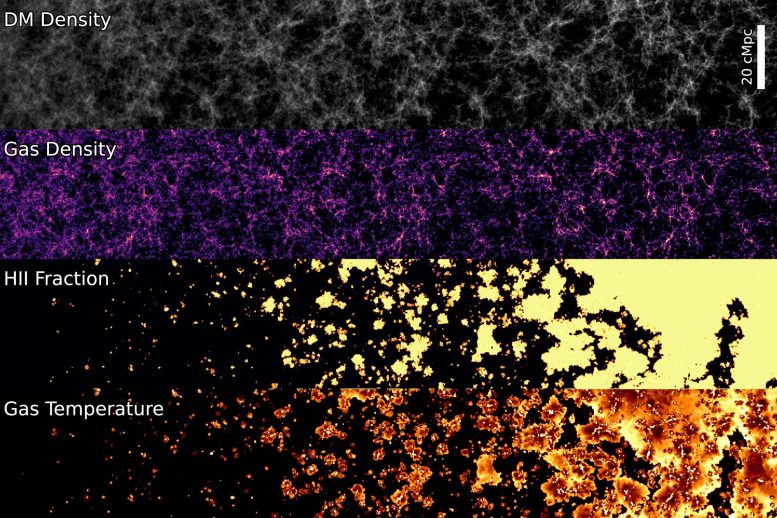
Thesan simülasyonu için küçük klip. Aşağıdaki makaledeki videoya bakın.
Adını şafak tanrıçasından alan Thesan’ın ilk milyar yıllık simülasyonları, radyasyonun erken evreni nasıl şekillendirdiğini açıklamaya yardımcı oluyor.
Her şey yaklaşık 13,8 milyar yıl önce, aniden ve şaşırtıcı bir şekilde evreni yaratan devasa bir kozmik “patlama” ile başladı. Yakında, bebek evren çarpıcı bir şekilde soğudu ve tamamen karanlık oldu.
Ardından, birkaç yüz milyon yıl sonra[{” attribute=””>Big Bang, the universe woke up, as gravity gathered matter into the first stars and galaxies. Light from these first stars turned the surrounding gas into a hot, ionized plasma — a crucial transformation known as cosmic reionization that propelled the universe into the complex structure that we see today.
Now, scientists can get a detailed view of how the universe may have unfolded during this pivotal period with a new simulation, known as Thesan, developed by scientists at MIT, Harvard University, and the Max Planck Institute for Astrophysics.
Named after the Etruscan goddess of the dawn, Thesan is designed to simulate the “cosmic dawn,” and specifically cosmic reionization, a period which has been challenging to reconstruct, as it involves immensely complicated, chaotic interactions, including those between gravity, gas, and radiation.
The Thesan simulation resolves these interactions with the highest detail and over the largest volume of any previous simulation. It does so by combining a realistic model of galaxy formation with a new algorithm that tracks how light interacts with gas, along with a model for cosmic dust.

Evolution of simulated properties in the main Thesan run. Time progresses from left to right. The dark matter (top panel) collapse in the cosmic web structure, composed of clumps (haloes) connected by filaments, and the gas (second panel from the top) follows, collapsing to create galaxies. These produce ionizing photons that drive cosmic reionization (third panel from the top), heating up the gas in the process (bottom panel). Credit: Courtesy of THESAN Simulations
With Thesan, the researchers can simulate a cubic volume of the universe spanning 300 million light years across. They run the simulation forward in time to track the first appearance and evolution of hundreds of thousands of galaxies within this space, beginning around 400,000 years after the Big Bang, and through the first billion years.
So far, the simulations align with what few observations astronomers have of the early universe. As more observations are made of this period, for instance with the newly launched James Webb Space Telescope, Thesan may help to place such observations in cosmic context.
For now, the simulations are starting to shed light on certain processes, such as how far light can travel in the early universe, and which galaxies were responsible for reionization.
“Thesan acts as a bridge to the early universe,” says Aaron Smith, a NASA Einstein Fellow in MIT’s Kavli Institute for Astrophysics and Space Research. “It is intended to serve as an ideal simulation counterpart for upcoming observational facilities, which are poised to fundamentally alter our understanding of the cosmos.”
Smith and Mark Vogelsberger, associate professor of physics at MIT, Rahul Kannan of the Harvard-Smithsonian Center for Astrophysics, and Enrico Garaldi at Max Planck have introduced the Thesan simulation through three papers, the third published on March 24, 2022, in the Monthly Notices of the Royal Astronomical Society.
Follow the light
In the earliest stages of cosmic reionization, the universe was a dark and homogenous space. For physicists, the cosmic evolution during these early “dark ages” is relatively simple to calculate.
“In principle you could work this out with pen and paper,” Smith says. “But at some point gravity starts to pull and collapse matter together, at first slowly, but then so quickly that calculations become too complicated, and we have to do a full simulation.”
To fully simulate cosmic reionization, the team sought to include as many major ingredients of the early universe as possible. They started off with a successful model of galaxy formation that their groups previously developed, called Illustris-TNG, which has been shown to accurately simulate the properties and populations of evolving galaxies. They then developed a new code to incorporate how the light from galaxies and stars interact with and reionize the surrounding gas — an extremely complex process that other simulations have not been able to accurately reproduce at large scale.
“Thesan follows how the light from these first galaxies interacts with the gas over the first billion years and transforms the universe from neutral to ionized,” Kannan says. “This way, we automatically follow the reionization process as it unfolds.”
Finally, the team included a preliminary model of cosmic dust — another feature that is unique to such simulations of the early universe. This early model aims to describe how tiny grains of material influence the formation of galaxies in the early, sparse universe.
Gaz evrimi ve radyasyonunun bu simülasyonu, nötr hidrojen gazının bir düzenlemesini gösterir. Renkler, yoğunluğu ve parlaklığı temsil ederek, yüksek yoğunluklu nötr gaz filamentlerinden oluşan bir ağ içindeki tamamlanmamış yeniden iyonlaşma yapısını ortaya çıkarır.
kozmik köprü
Simülasyon bileşenleri yerindeyken ekip, Big Bang’in kalan ışığının kesin ölçümlerine dayanarak, Big Bang’den sonraki yaklaşık 400.000 yıl için başlangıç koşullarını belirledi. Daha sonra, dünyanın en büyük süper bilgisayarlarından biri olan SuperMUC-NG makinesini kullanarak, aynı anda 30 milyon CPU’ya eşdeğer Thesan hesaplamaları yapmak için 60.000 bilgisayar çekirdeğinden yararlanarak, evrenin bir bölümünü simüle etmek için bu koşulları zamanda ileriye doğru geliştirdiler. bir saat (tek bir masaüstünde çalışması 3.500 yıl sürecek bir çaba).
Simülasyonlar, var olan herhangi bir simülasyonun en büyük uzay hacmi boyunca kozmik yeniden iyonlaşmanın en ayrıntılı görünümünü üretti. Bazı simülasyonlar büyük mesafeler boyunca ilerlerken, bunu nispeten düşük bir çözünürlükte gerçekleştirirken, diğer, daha ayrıntılı simülasyonlar büyük boyutlara yayılmaz.
Vogelsberger, “Bu iki yaklaşım arasında geçiş yapıyoruz: yüksek hacme ve yüksek hassasiyete sahibiz” diye vurguluyor.
Simülasyonların ilk analizleri, kozmik yeniden iyonlaşmanın sonunda, ışığın seyahat edebileceği mesafenin bilim adamlarının önceden varsaydığından çok daha fazla arttığını gösteriyor.
Canan, “Thesan, ışığın erken evrende büyük mesafeler kat etmediğini buldu” diyor. “Aslında, bu mesafe çok küçüktür ve yalnızca yeniden iyonlaşmanın sonunda genişler, sadece birkaç yüz milyon yılda 10 kat artar.”
Araştırmacılar ayrıca yeniden iyonlaşmadan sorumlu galaksilerin türü hakkında ipuçları görüyorlar. Ekip, James Webb ve diğer gözlemevleri tarafından alınan daha fazla gözlemin bu baskın gökadaları tanımlamaya yardımcı olacağını söylese de, gökadanın kütlesi yeniden iyonlaşmayı etkiliyor gibi görünüyor.
“İçeride çok fazla hareketli parça var. [modeling cosmic reionization]’ diye bitiriyor Vogelsberger: “Bütün bunları bir tür makinede bir araya getirip, onu çalıştırmaya ve dinamik bir evrene yol açmaya başladığımızda, bu hepimiz için çok tatmin edici bir andır.”
Referans: A Smith, R. Cannan, E. Garaldi, M. Vogelsberger, R. Buckmore, Sprinkle ve L. Hernquist, 24 Mart 2022, Mevcut burada. Kraliyet Astronomi Derneği’nin Aylık Bildirimleri.
DOI: 10.1093/mnras/stac713
Bu araştırma kısmen NASA, Ulusal Bilim Vakfı ve Gauss Süper Hesaplama Merkezi tarafından desteklendi.

“Analist. Tutkulu zombi gurusu. Twitter uygulayıcısı. İnternet fanatiği. Dost pastırma hayranı.”




More Stories
Yüksek mineralli dişlere sahip somonla tanışın
Salı günü Cape Canaveral'dan Starlink misyonu
Hubble 34. yıl dönümünü Küçük Halter Bulutsusu'na bakarak kutluyor